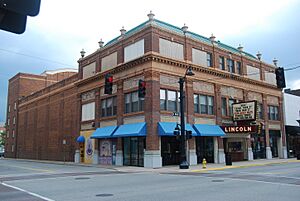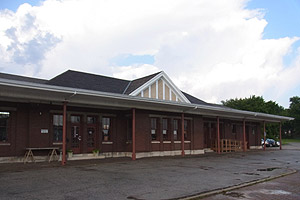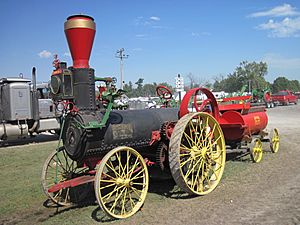Belleville, Illinois facts for kids
Quick facts for kids
Belleville, Illinois
|
|
|---|---|
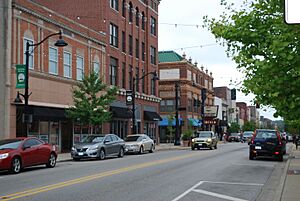
Main Street
|
|
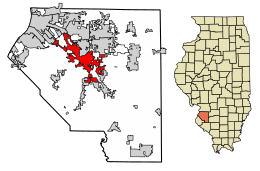
Location of Belleville in St. Clair County, Illinois
|
|
| Country | |
| State | |
| County | |
| Founded | 1814 |
| Area | |
| • Total | 23.49 sq mi (60.84 km2) |
| • Land | 23.23 sq mi (60.17 km2) |
| • Water | 0.26 sq mi (0.67 km2) |
| Elevation | 502 ft (153 m) |
| Population
(2020)
|
|
| • Total | 42,404 |
| • Density | 1,825.16/sq mi (704.71/km2) |
| Time zone | UTC−6 (CST) |
| • Summer (DST) | UTC−5 (CDT) |
| ZIP Codes |
62220–62223, 62225, 62226
|
| Area code(s) | 618 |
| FIPS code | 17-163-04858 |
| GNIS feature ID | 2394118 |
Belleville is a city in St. Clair County, Illinois, United States. It is the county seat, meaning it's where the county government is located. In 2020, about 42,404 people lived there. This makes Belleville the biggest city in the Metro East area and all of Southern Illinois. Many military and federal workers live here because it's close to Scott Air Force Base. Belleville is also home to the Roman Catholic Diocese of Belleville and the National Shrine of Our Lady of the Snows.
Contents
History of Belleville
Belleville was named in 1814 by George Blair. He chose the French name belle ville, which means "beautiful city." Blair gave land for the town square and more land for the new county seat. This led to the county seat moving from Cahokia to Belleville.
Belleville became a village in 1819 and a city in 1850. Many people from Germany moved here in the mid-1800s. They came after the German Revolution failed in 1848. By 1870, most of the city's population was of German background.
Belleville's Industries and Growth
After the Civil War, Belleville became a busy place for making things. Factories produced nails, printing presses, and farm tools. It was even known as "The Stove Capital of the World." The first brewery in Illinois was also in Belleville. In 1868, Gustav Goelitz started a candy company. Today, it's famous for "Jelly Belly" candies.
A huge amount of bituminous coal was found nearby. By 1874, many farmers became coal miners. Over 100 mines were working in and around Belleville. Coal helped bring the steam railroad to town. This allowed tons of coal to be sent to St. Louis every day. Later, Belleville had the first electric trolley in Illinois.
Historic Homes and Districts
Early homes in Belleville were simple brick cottages. They were called "German street houses" or "row houses." Over time, many different styles of homes were built. These included American Foursquare and Victorian styles.
The Belleville Historic District was added to the National Register of Historic Places in 1976. The city also has two other historic areas: "Hexenbuckel" and "Oakland."
Education and Community Life
Early German immigrants in Belleville were often well-educated. They were sometimes called "Latin Farmers." In 1836, Gustav Koerner helped start the city's public library. The Belleville Public Library is the oldest in Illinois. These German settlers also formed music and drama groups. They even started one of the first kindergartens in the United States.
In 1990, Belleville became the most populated city in the Metro East and Southern Illinois. This was based on US Census data. In 2011, Belleville won the All-America City Award. In 2021, Patty Gregory was elected as Belleville's first female Mayor.
Geography and Climate
Belleville is located at 38°31′18″N 89°59′43″W / 38.52167°N 89.99528°W. The city covers about 23.49 square miles (60.84 square kilometers). Most of this area is land. Richland Creek flows through a large part of Belleville.
Belleville's Weather
Belleville has a changing climate with warm summers and cold winters.
| Climate data for Belleville SIU Research, Illinois (1991–2020 normals, extremes 1948–present) | |||||||||||||
|---|---|---|---|---|---|---|---|---|---|---|---|---|---|
| Month | Jan | Feb | Mar | Apr | May | Jun | Jul | Aug | Sep | Oct | Nov | Dec | Year |
| Record high °F (°C) | 75 (24) |
83 (28) |
89 (32) |
91 (33) |
97 (36) |
106 (41) |
110 (43) |
105 (41) |
103 (39) |
96 (36) |
84 (29) |
77 (25) |
110 (43) |
| Mean maximum °F (°C) | 64.0 (17.8) |
70.2 (21.2) |
78.6 (25.9) |
84.7 (29.3) |
89.8 (32.1) |
95.2 (35.1) |
97.3 (36.3) |
96.8 (36.0) |
93.5 (34.2) |
87.3 (30.7) |
75.2 (24.0) |
65.5 (18.6) |
98.8 (37.1) |
| Mean daily maximum °F (°C) | 42.9 (6.1) |
48.6 (9.2) |
59.2 (15.1) |
70.6 (21.4) |
79.1 (26.2) |
87.3 (30.7) |
90.2 (32.3) |
89.1 (31.7) |
83.3 (28.5) |
72.6 (22.6) |
58.1 (14.5) |
46.3 (7.9) |
68.9 (20.5) |
| Daily mean °F (°C) | 33.6 (0.9) |
38.3 (3.5) |
47.8 (8.8) |
58.3 (14.6) |
67.7 (19.8) |
75.9 (24.4) |
79.0 (26.1) |
77.2 (25.1) |
70.1 (21.2) |
59.7 (15.4) |
47.5 (8.6) |
37.3 (2.9) |
57.7 (14.3) |
| Mean daily minimum °F (°C) | 24.3 (−4.3) |
28.0 (−2.2) |
36.3 (2.4) |
46.0 (7.8) |
56.3 (13.5) |
64.5 (18.1) |
67.8 (19.9) |
65.3 (18.5) |
56.9 (13.8) |
46.7 (8.2) |
36.9 (2.7) |
28.3 (−2.1) |
46.4 (8.0) |
| Mean minimum °F (°C) | 1.7 (−16.8) |
8.6 (−13.0) |
16.3 (−8.7) |
28.7 (−1.8) |
39.7 (4.3) |
50.7 (10.4) |
56.5 (13.6) |
53.4 (11.9) |
40.3 (4.6) |
27.8 (−2.3) |
18.0 (−7.8) |
8.4 (−13.1) |
−1.8 (−18.8) |
| Record low °F (°C) | −27 (−33) |
−21 (−29) |
−8 (−22) |
18 (−8) |
28 (−2) |
38 (3) |
43 (6) |
39 (4) |
26 (−3) |
20 (−7) |
2 (−17) |
−19 (−28) |
−27 (−33) |
| Average precipitation inches (mm) | 2.56 (65) |
2.16 (55) |
3.44 (87) |
4.90 (124) |
5.05 (128) |
4.62 (117) |
4.03 (102) |
3.92 (100) |
3.35 (85) |
3.12 (79) |
3.60 (91) |
2.61 (66) |
43.36 (1,101) |
| Average snowfall inches (cm) | 3.4 (8.6) |
3.3 (8.4) |
1.0 (2.5) |
0.0 (0.0) |
0.0 (0.0) |
0.0 (0.0) |
0.0 (0.0) |
0.0 (0.0) |
0.0 (0.0) |
0.0 (0.0) |
0.6 (1.5) |
2.9 (7.4) |
11.2 (28) |
| Average precipitation days (≥ 0.01 in) | 7.1 | 7.5 | 9.5 | 10.3 | 11.5 | 8.7 | 7.4 | 7.2 | 6.6 | 8.4 | 7.7 | 7.7 | 99.6 |
| Average snowy days (≥ 0.1 in) | 2.2 | 1.9 | 0.6 | 0.0 | 0.0 | 0.0 | 0.0 | 0.0 | 0.0 | 0.0 | 0.4 | 1.9 | 7.0 |
| Source: NOAA | |||||||||||||
People of Belleville
| Historical population | |||
|---|---|---|---|
| Census | Pop. | %± | |
| 1850 | 2,941 | — | |
| 1860 | 7,520 | 155.7% | |
| 1870 | 8,146 | 8.3% | |
| 1880 | 10,683 | 31.1% | |
| 1890 | 15,361 | 43.8% | |
| 1900 | 17,484 | 13.8% | |
| 1910 | 21,122 | 20.8% | |
| 1920 | 24,823 | 17.5% | |
| 1930 | 28,425 | 14.5% | |
| 1940 | 28,405 | −0.1% | |
| 1950 | 32,721 | 15.2% | |
| 1960 | 37,264 | 13.9% | |
| 1970 | 41,223 | 10.6% | |
| 1980 | 41,580 | 0.9% | |
| 1990 | 42,785 | 2.9% | |
| 2000 | 41,410 | −3.2% | |
| 2010 | 44,478 | 7.4% | |
| 2020 | 42,404 | −4.7% | |
| 2023 (est.) | 40,726 | −8.4% | |
| U.S. Decennial Census | |||
In 2000, Belleville had 41,410 people. There were 17,603 households and 10,420 families. The population density was about 2,196 people per square mile. Most residents were White (81.51%) or African American (15.51%).
About 28.4% of households had children under 18. The average household had 2.27 people. The average family had 2.95 people. The median age was 37 years old.
Belleville in 2010
By 2010, Belleville's population grew to 44,478 people. There were 18,795 households. The racial makeup was 69.8% White and 25.4% African American. About 2.6% of the population was Hispanic or Latino.
About 27.7% of households had children under 18. The average household size was 2.3 people. About 12.9% of the population was 65 years or older.
Arts and Culture in Belleville
The Belleville Philharmonic Society started in 1866. It is the second oldest orchestra in the United States. As more people moved to Belleville, especially from the South, new music styles grew. These included blues and jazz. Later, rock clubs became popular.
Several famous musicians are from Belleville. These include Jay Farrar and Jeff Tweedy from the band Uncle Tupelo. Neal Doughty, the keyboardist for REO Speedwagon, is also from Belleville.
Historic Places to Visit
Belleville has several places listed on the National Register of Historic Places:
- Belleville Historic District
- Gustave Koerner House
- Knobeloch-Seibert Farm
Sports in Belleville
Belleville is home to the Rowdies Rugby Football Club. This is the only rugby team in the area. Lindenwood Stadium is a college football stadium known for its unique red and gray stripes.
Belleville also had a minor league baseball team called the Belleville Stags. They played from 1947 to 1949. The Stags were part of the Illinois State League, which later became today's Midwest League.
Education in Belleville
Belleville has public high schools managed by Belleville Township High School District 201. These are Belleville High School-East and Belleville High School-West. There are also private high schools like Althoff Catholic High School.
Several grade school districts serve Belleville. These include Belleville School District 118 and Belle Valley School District 119. There are also Catholic grade schools like St. Peter's Cathedral School. For higher education, Belleville has Southwestern Illinois College, which is a public community college.
Media and News
The Belleville News-Democrat is the city's daily newspaper. It covers news for the Metro East area and Southwestern Illinois. Belleville also receives TV and radio signals from St. Louis.
Getting Around Belleville
Belleville has three St. Louis MetroLink stations. These light rail stations connect the city to St. Louis. Major state highways like Illinois Route 15 and Illinois Route 159 pass through Belleville. The city is also near Interstate highways 64 and 255. I-64 is a main route to downtown St. Louis.
Belleville has a bicycle trail for fun and exercise. It runs from Southside Park to Southwestern Illinois College and Scott Air Force Base. For air travel, people use Scott Air Force Base and MidAmerica St. Louis Airport. The closest major airport is St. Louis Lambert International Airport.
Notable People from Belleville
Many interesting people have come from Belleville:
- Ninian Edwards (1775–1833), a former Governor of Illinois
- John Reynolds (1788–1865), another former Governor of Illinois
- Buddy Ebsen, a famous American actor and dancer
- Jay Farrar, a musician and songwriter
- Sandra Magnus, an American engineer and former NASA astronaut
- Darius Miles, a former professional basketball player
- Jeff Tweedy, a musician, songwriter, and author
- Kevin Von Erich, a retired professional wrestler
- Jimmy Connors, a former world No. 1 tennis player
Sister City
Belleville has one sister city:
 Paderborn, Germany
Paderborn, Germany
See also
 In Spanish: Belleville (Illinois) para niños
In Spanish: Belleville (Illinois) para niños







